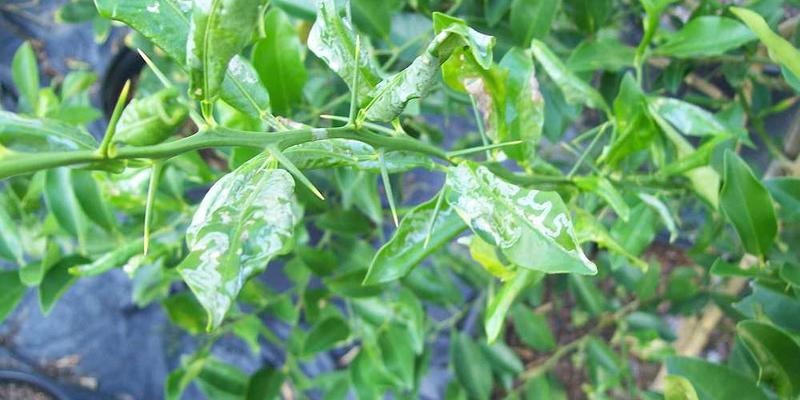
The number one issue this season for Lowcountry citrus growers has been the dreaded citrus leafminer. Why? The answer is unclear. Maybe it has to do with the warmer than usual winter we had last year? Perhaps it's because more people are growing citrus? All I know is, it is bad and I want to get the word out about what it looks like, what to do about it, and possibly how to help slow it down.

Citrus leafminer moth at rest
The citrus leafminer (phyllocnistis citrella) is a moth of the gracillariidae family. Though it's native to Asia, the leafminer (or CLM) has spread to nearly every citrus-growing area in the world. It was first found in Florida in 1993 and, since then, has slowly moved northward (like to the Lowcountry). The larvae of this moth are little worm-like creatures that form serpentine mines in the leaves and occasionally the fruit of their host. Their host plants are all citrus (orange, lemon, lime, grapefruit, tangerine, etc.), or a citrus relative—kumquats and such. CLM moths are attracted to new flushes of growth, which citrus plants tend to have multiple periods of throughout the year, because once the plants' leaves harden, the pest is not be able to mine and the moth will not lay her eggs there.
For the most part, this insect only causes cosmetic damage. Mature citrus trees (more than four years old) generally tolerate this leaf damage without any effect on tree growth or fruit yield. On a large tree it isn't a problem because there are plenty of leaves on the tree to compensate. On a small tree, however, the leaf count is much smaller. CLM can cause damage in new plantings because the growth of the young tree is retarded by the infestations. The good news is, even when infestations of the leafminer are heavy on young trees, they are unlikely to die. (There is one report floating around though that heavy infestations may affect production on certain mature trees, but this has been demonstrated only on limes.)
Controlling the pest is the hardest part. Scouting your tree(s) at least once a week will help nip this problem before it gets too out of hand.
Here are some signs to look for:
1. Leaves with serpentine mines

2. Curling of leaves (which may harbor mealybugs also)

3. A silvery film over the top of the leaf

PREVENTION:
Insecticide: The larvae are protected by the leaves epidermis as it tunnels through, so contact insecticide is temporary at best. It is effective for only two to three weeks because citrus leafminer adults lay eggs on the new flush of growth that was not present at the time of any treatment.
Horticultural oils: These have been shown to work as a deterrent, as the adult female will not lay her eggs on the oily surface. But they should be used with care to avoid phytotoxicity (becoming toxic to the plant).
Spinosad: An all-natural chemical you will want to start using as soon as you see any of the telltale tunnels. Drawback: it is very expensive and hard to find.
Systemic: An insecticide that the plant takes up from its roots. This actually gets into the plant where the larvae are and kills them. Remember: if you use any chemical control, read the label and follow it. That IS the law!
There are also traps baited with a pheromone (insect sex attractant) that are available for CLM. This is a useful tool for determining when moths are flying and depositing eggs. For the homeowner who only owns one or two trees, this is probably not economically feasible.
Do not prune off the leaves damaged by CLM. The undamaged areas of the leaves may continue to produce food for the tree. If the leaf is not working properly, the tree will discard it itself.

Mature leaf with CLM damage, still producing food
Hopefully this has answered your questions that you may have had but didn't know what to ask.
As always, if you have any questions about this or any of my other posts, feel free to contact me at: TheCitrusGuy@netzero.com
Happy Growing!
Darren